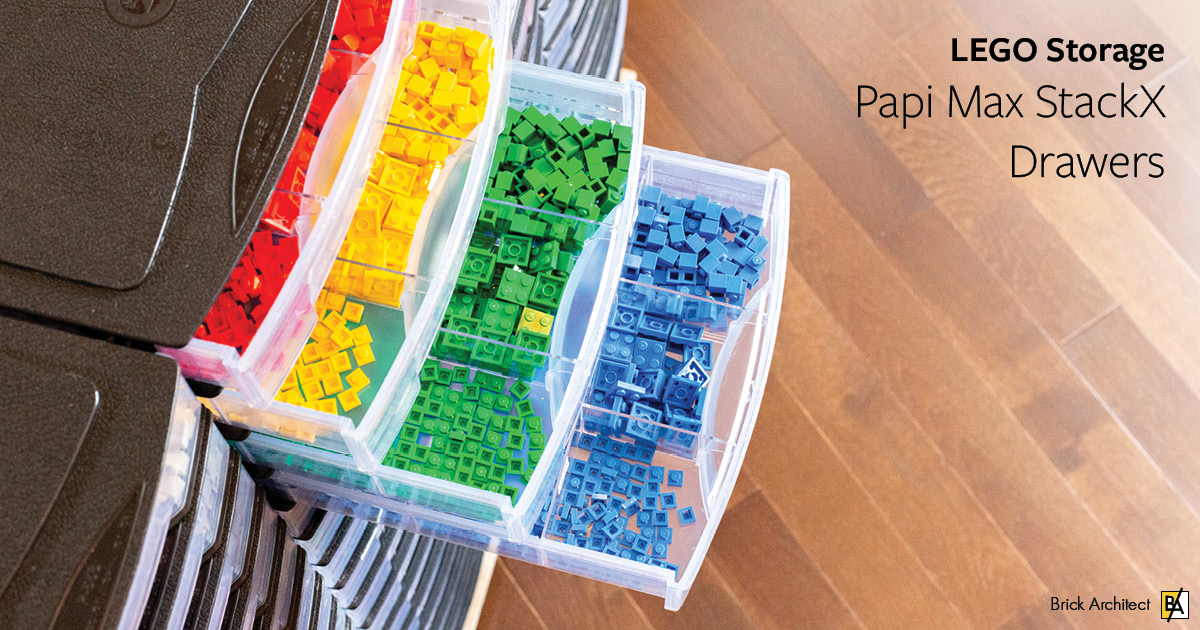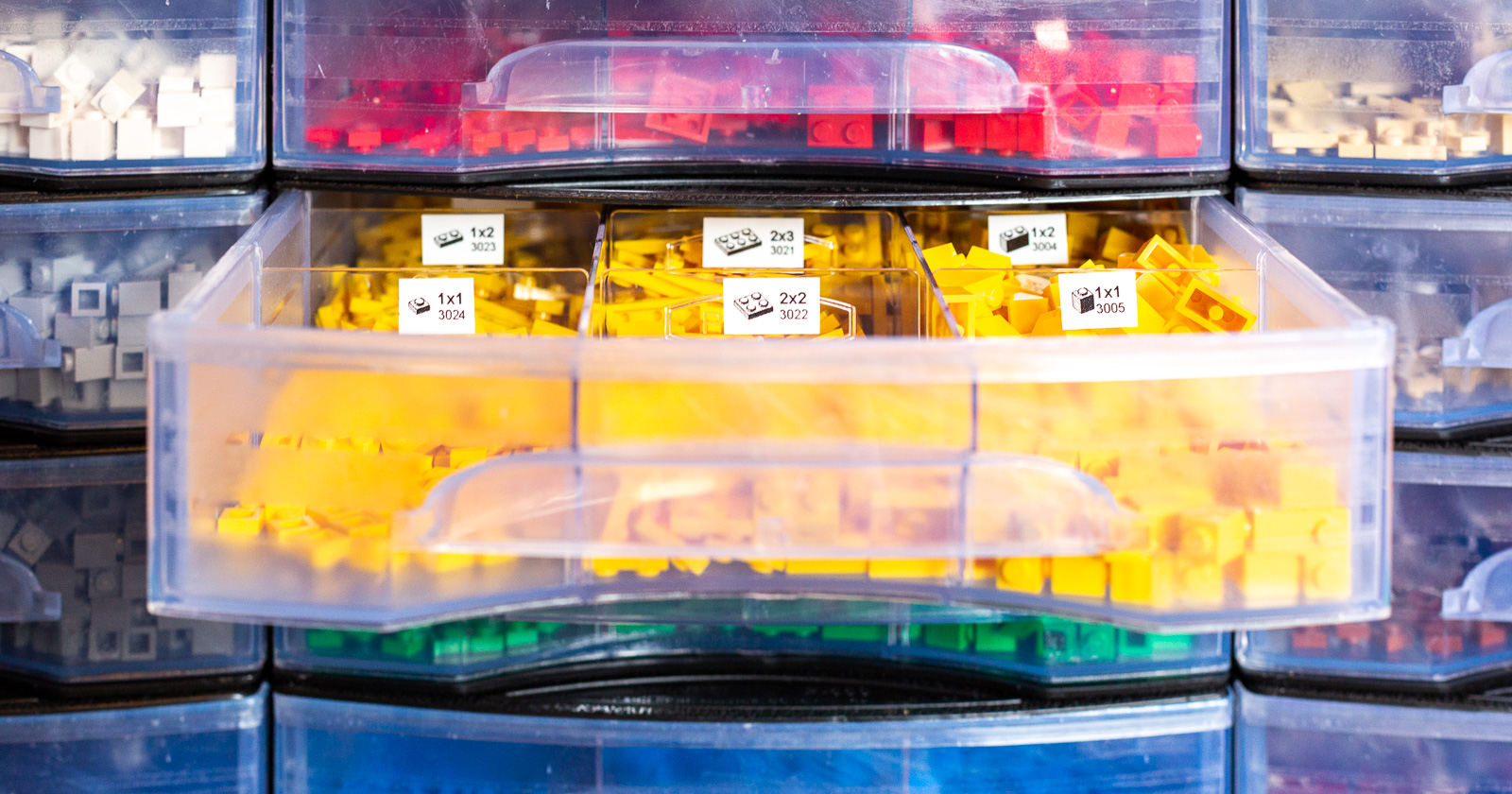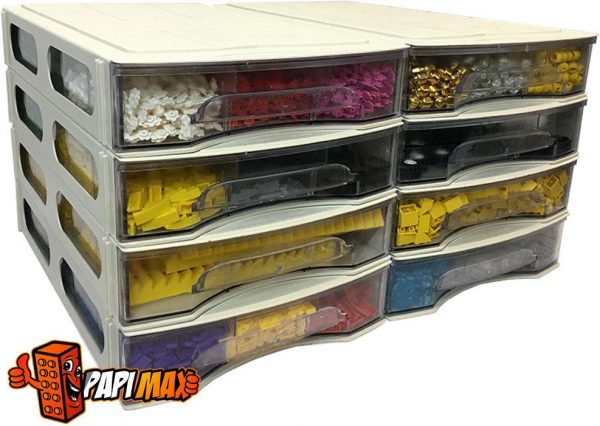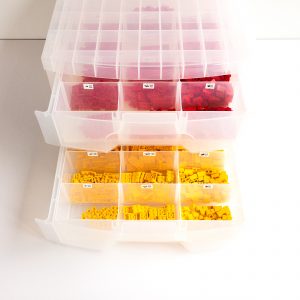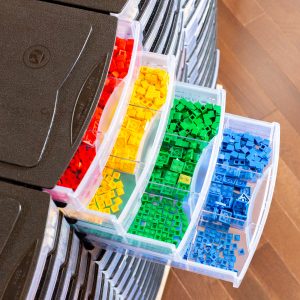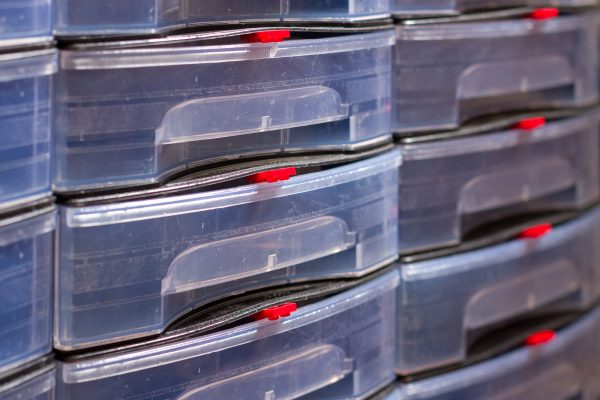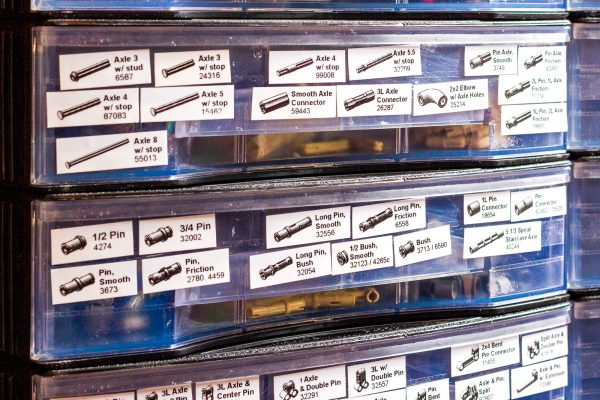Review: Papi Max StackX Drawers
Intrigued by the promise to store a very well organized LEGO collection in the minimum amount of space, I’ve given Papi Max StackX drawers a test drive in my home. Let’s find out if they would be a good match for your collection.
April 1, 2022: As of 2020, the product described on this page is no longer being sold by Papi Max. (It has been permanently discontinued.)
You may be able to order from distributors in China, where the product is sold with the branding “Manbei” and product number “P-558”. A cursory investigation reveals that economy shipping to North America is greater than the cost of the drawers themselves, making this a costly proposition.
I have been a long-time advocate of the Akro-mils 64-drawer cabinets, which I’ve used for years to sort most of my collection with a separate drawer for each unique part. If you have enough wall space, they are a nearly perfect LEGO storage solution.
Unfortunately, many LEGO enthusiasts have limited space, which is why I was excited to try the Papi Max StackX drawers, which claim to allow you to store three times as many LEGO parts in the same amount of space. Let’s find out how well they stack up to the competition!
Papi Max StackX Drawers
I learned about Papimax StackX while researching my LEGO Storage Guide. They are designed specificially for LEGO enthusiasts and claim that they are “3× more efficient” than competing products.
Papi Max is based in the UK, but recently started selling their StackX products in the USA. Each StackX unit consists of a drawer with removeable dividers allowing up to 15 individual compartments, and a stackable base. Unlike the Akro-mils style drawer compartments, the bases are designed to interlock both horizontally and vertically to create a custom storage solution of any size. This allows you to make a small vertical tower, or a massive grid of drawers.
Technical Specifications:
- Cabinet exterior dimensions (per drawer): 23.1 × 37.1 × 6 cm tall. (9″ × 14 5/8″ × 2 3/8″ tall.)
- Drawer interior dimensions:21.5 × 33.5 × 4.8 cm tall. (8 1/2″ × 13 1/4″ × 1 7/8″ tall.)
- Compartment interior dimensions:7.0 × 6.6 × 4.8 cm tall. (2 3/4″ × 2 5/8″ × 1 7/8″ tall.)
In LEGO units, each compartment can store parts that are up to 8×8 studs wide, and a little less than 5 bricks tall.
Availability
Because Papimax is based in the UK, their products have been available in Europe for some time now at papimax.co.uk.
Thankfully, they have recently began to distribute their products in the USA. At this time, they are only available direct from papimax.com. (You will find that shipping is pretty expensive, especially compared to other storage products you can purchase with free or discounted shipping through volume sellers like Amazon.)
Pricing
The drawers are sold in sets of 8 drawers for about 100$ (128$ with shipping to Seattle, WA). They sometimes offer coupon codes for up to 25% off, bringing the total cost with shipping to around 100$ for 8 drawers.
With the included dividers, that’s up to 120 compartments. (About twice as many compartments as a single 64-drawer Akro-mils cabinet.)
Related Products
This product is designed for people who have a very well organized LEGO collection, with a single compartment for each unique part, or for each unique part and color.
There are four product categories which people with very large LEGO collections use to organize their LEGO collections:
- Drawer Cabinets – Each drawer contains just one part type. (Akro-mils is most popular in USA.)
- Drawers with dividers – Each drawer contains many compartments, with just one part type in each compartment. (Papimax StackX is an example of this type of storage.)
- Tackle Boxes (with removeable or non-removeable compartments) – Each box contains multiple compartments, with just one part type in each compartment. Some products allow you to remove each compartment individually.
- Plastic Bags – Each bag contains just one part type. (Bags are typically place within larger drawers or stackable bins.)
All of these products are discussed at length in the ‘large collections’ section of my LEGO Storage Guide.
Really Useful Products makes high quality drawers designed for scrapbooking, with an optional 15-compartment insert that works great for large LEGO collections. These are really large drawers that can hold a lot of LEGO bricks.
Brick Architect rated it “Very Good” (3/5 stars). Read the Review.
This UK company makes the only storage drawers designed specifically for LEGO Bricks. Dividers are removeable, allowing up to 15 compartments which fit parts up to 8×8 studs wide.
Brick Architect rated it “Very Good” (3/5 stars). Read the Review.
Plastic drawer cabinets by Akro-Mils are the top pick for most LEGO enthusiasts in the USA. They have several advantages over other options including: drawers are easily removed and stack-able, drawers are deep enough for 16-stud bricks, drawers are flexible which makes them hard to break, and have competitive prices.
Other drawers with dividers
There isn’t a lot of competition for drawers with dividers. Besides ludicrously expensive business-class solutions by companies like Schaller, the only direct competitor in this space are the Really Useful Scrapbook Drawers which we reviewed recently.
There aren’t very many products in this category. The only other product which is popular with LEGO artists is the Really Useful Scrapbook Drawers with the 15-compartment ‘Hobby Tray’ insert. This isn’t a direct comparison to the StackX product, because each compartment in the Really Useful solution is about three times as large as the StackX compartment. The large compartments might be perfect for very common pieces that are sorted by color and you have in large quantities, but impractical for smaller collections or less common parts.
I do prefer that the Hobby Tray is a single molded insert, rather than individual horizontal and vertical dividers in the Papimax StackX system. It’s easier to get parts out of the bottom of each compartment because the bottom corners of each compartment are slightly rounded. Further, the dividers do not run the risk of coming out, allowing pieces to slide around.
Capacity
The following table shows the dimensions and storage capacity for each of these similar products.
| Unit Dimensions | Unit Volume | Compartments per Unit | Compartment Dimensions | Compartment Volume | Qty 1×1 plates | |
|---|---|---|---|---|---|---|
| Papi Max StackX | 23.1 × 37.1 × 6 cm tall (9″ × 14 5/8″ × 2 3/8″ tall) |
5.142 L | 15 | 7.0 × 6.6 × 4.8 cm tall | 222 mL | 552 |
| Really Useful Scrapbook Drawer w/ Hobby Tray | 39.5×42 × 11cm tall (15 9/16″ × 16 9/16″ × 4 5/16″ tall) |
18.249 L | 15 | 10.1 × 7.2 × 7.6cm tall | 552 mL | 1398 |
| Akro-mils 24-drawer Cabinet | 50.5 × 16.1 × 40 cm tall (19 7/8″ × 6 5/16” × 15 ¾″ tall) |
32.522 L | 24 | 10.8 × 13.5 × 5.0 cm tall | 729 mL | 1893 |
| Akro-mils 64-drawer Cabinet | 50.5 × 16.1 × 40 cm tall (19 7/8″ × 6 5/16″ × 15 ¾″ tall) |
32.522 L | 64 | 5.1 × 13.5 × 3.5cm high | 241 mL | 563 |
Notes:
- “Qty 1×1 plates” is the maximum number of pieces that fit while allowing the drawer to open and close without getting stuck. This was measured experimentally, and is the average of several measurements for each product.
- The divider in the Papi-max drawer is slightly shorter than the drawer itself, which seems like a bad idea, but makes it harder to over-fill the compartment and cause drawer to get stuck when opening and closing.
Storage Density
If you have a huge LEGO collection, a small LEGO room, or both, you need to make sure your storage solution uses the space efficiently. (Space which is occupied by the storage solution itself can’t be used to store more LEGO!)
In some rooms, the most limited resource will be wall space, while in other rooms the bigger issue is overall volume. If the room is plenty deep but has limited wall space, a deeper storage product might be more efficient. If you have a narrow hallway with a ton of wall space, a shallow product like Akro-mils Drawer Cabinets might make the most sense. That’s why I’ve included both overall Storage Density (as percentage of storage product’s overall volume), as well as Storage Capacity as a function of wall space.
| Unit Volume | Unit Wall Space | Compartments per Unit | Compartment Volume | % Storage Density | Wall Space Storage Volume | |
|---|---|---|---|---|---|---|
| Papi Max StackX | 5.142 L | 0.014 sq m | 15 | 211 mL | 62% | 228.3 L/sq m |
| Really Useful Scrapbook Drawer w/ Hobby Tray | 18.249 L | 0.043 sq m | 15 | 560 mL | 46% | 193.2 L/sq m |
| Akro-mils 24-drawer Cabinet | 32.522 L | 0.202 sq m | 24 | 729 mL | 54% | 86.6 L/sq m |
| Akro-mils 64-drawer Cabinet | 32.522 L | 0.202 sq m | 64 | 241 mL | 47% | 76.3 |
As you can see, the Papi Max StackX drawers are extremely efficient with space. This is even more impressive given that the StackX drawers are 5 cm (2″) shallower than the Really Useful Scrapbook Drawers, while storing 15% more pieces in the same amount of wall space, and 25% more pieces in the same volume. The Akro-mils products are also fairly efficient, but only if you have a ton of wall space.
Value
Lastly, I calculated the cost per liter of storage for all four of these products.
| Compartments per Unit | Compartment Volume | Total Storage Volume | Cost per unit | Cost per Liter | |
|---|---|---|---|---|---|
| Papi Max StackX | 15 | 222 mL | 3.2 L | $12.50 | $3.95 |
| Really Useful Scrapbook Drawer w/ Hobby Tray | 15 | 552 mL | 8.4 L | $20.22 | $2.41 |
| Akro-mils 24-drawer Cabinet | 24 | 729 mL | 17.5 L | $30 (typical) | $1.71 |
| Akro-mils 64-drawer Cabinet | 64 | 241 mL | 15.4 L | $35 (typical) | $2.27 |
Unfortunately, StackX products are quite expensive. At $3.95 per liter, it is nearly twice as expensive as the other options highlighted in this table. For some people, the higher price may be justified by the higher storage density, and the fact that the compartments are perfectly sized to meet the needs of LEGO enthusiasts.
How does it stack up?
Every decision which is made when designing storage products comes at a tradeoff. These decisions impact storage efficiency, portability, flexibility, durability, convenience, and cost to name a few—that’s why there is no such thing as a “perfect” storage solution. With that in mind, I will walk through the key attributes of the Papi Max StackX product and explain the strengths/weaknesses of each of these design decisions.
Removeable Dividers
One of the key differences compared to similar products is the decision to use removeable dividers instead of a fixed insert. Because Papi Max StackX was designed specifically for LEGO enthusiasts, you will be happy to learn that each compartment was designed to hold pieces up to 8×8 studs wide, and just shy of 5 bricks tall. This means that the vast majority of common LEGO pieces will fit into a single compartment.
Per 2019 Most Common LEGO Parts, the vast majority of common parts will fit easily in a single compartment. (87th place is #4477 1×10 plate, and 118th place is #3832 2×10 plate. Both will fit diagonally in a single compartment.)
The removeable dividers make it possible to store even larger pieces in each compartment. By removing a single divider you have three fewer compartments in that drawer, but each compartment can store pieces up to 8×16 studs wide. (You can remove even more dividers to store really large pieces.) This is a huge advantage of this product, since you don’t need to resort to a different LEGO storage product for pieces which are a bit too large.
This flexibility comes at a cost—the removeable inserts do not snap firmly in place, which can cause the divider to slide up while trying to remove pieces from the drawer. If it slides up too far, pieces can slide under the divider and end up in the wrong compartment. This is a challenging situation to fix, as parts usually end up stuck underneath the divider, so I often needed to remove all of the parts in the drawer and re-sort the pieces to remedy the issue.
This problem can be fixed easily using an inexpensive hot glue gun. Because the two vertical dividers are inserted after the four horizontal dividers, a single dab of hot glue at the top and bottom of those two dividers keeps them from sliding up during regular use. Hot glue is soft enough that it can be scraped off if you need to re-configure the drawer in the future. While an easy fix, I was disappointed to learn that the product needs to be modified to meet my needs.
Another disadvantage of removeable dividers is that they result in perfectly square bottom corners, as opposed to a molded insert which can have slightly rounded corners. When the corner is slightly rounded, it is easier to remove parts as they slide up naturally when you try to scoop them with your fingers. (It takes about three times as long to remove the same number of pieces from a compartment in the StackX drawer than from the Really Useful Hobby Tray.) This is not a dealbreaker, it just makes the product a bit more frustrating in everyday use.
Hard Plastic
Akro-mils and Really Useful Products use a softer polypropylene plastic, whereas StackX uses a harder plastic material. Because harder plastics bend less easily, the drawers are thinner resulting in greater storage density. The harder plastic is slightly clearer, so you can see what’s inside each drawer more easily.
That said, harder plastics crack much more easily, so you should treat your drawers and dividers with care. There’s also the question of personal preference—I think that softer plastic containers are nicer to handle, and I don’t worry as much about scratching my LEGO pieces when stored in soft plastic containers.
I also found that the hard plastic used on the stackable trays which each drawer slides into are slightly warped at the top, preventing some drawers from sliding in all the way. I was able to fix this easily, by bending the plastic upwards using a 2×2 plate squeezed in-between the drawer and the tray. Allowing it to sit overnight like this fixed the issue for almost every drawer.
Removeable Compartments
One of my favorite things about the popular Akro-mils cabinets is that each drawer can be removed separately. This is extremely helpful when one compartment contains multiple colors of the same piece, because I can dump out the entire drawer, find the pieces I need, and slide the rest back into the drawer. Unfortunately, StackX drawers do not feature individually removeable compartments, so you need to carefully dig through the pieces in a specific compartment to find the piece you need.
Removeable compartments are possible when parts are stored in drawers, but thus far have not been made available in products aimed at the consumer market. A variation of this product with slightly larger drawers, and removeable storage cups would be a pretty big upgrade, although storage density would be slightly reduced since the cups would require more plastic (Professional storage products typically utilize large heavy-duty metal drawers that open and close smoothly on ball bearings.

Professional Storage Solution with removable compartments. (Photo: Schaller Corporation)
Companies like Schaller Corporation manufacture removeable square cups which can be placed in these large cabinets. (Systems like this are used at the LEGO HQ in Billund, Denmark.)
My Collection
With a growing family and a small Seattle home, I’m in the process of moving my LEGO collection from a large bedroom into a very small office. The extremely high storage density was reason enough to purchase 7 additional boxes of Papi Max StackX drawers for my own collection, for a total of 64 drawers. While this would allow up to 960 compartments, my final configuration required a fair number of double-sized compartments for parts which more than 8 studs long. This allowed me to get rid of about half of my Akro-mils cabinets. (The remaining cabinets will be used to store less common parts which aren’t sorted by color.)
Half of the StackX drawers are dedicated to common Bricks/Plates/Tiles which are sorted by element (both part and color). I’m using 1 ½ drawers for each of the 16 most common colors, with additional drawers containing parts in the remaining colors. Having a whole drawer containing common parts in each color is convenient, since I can remove that drawer and bring it over to my build space.
The other half of the drawers are storing my Technic collection. I chose to put Technic elements into the StackX drawers rather than keep them in the Akro-mils cabinets because many Technic elements come in only one color, and I do not use Technic elements as frequently as System elements. This works pretty well, but it’s difficult to fit 15 labels on the front of each drawer!
Potential Improvements
While it is already well suited for some LEGO collections, there are a number of changes which would make this product appealing to even more LEGO fans.
- Removeable compartments – If each compartment could be removed separately, I could store multiple colors in the same compartment since it would be easy to dump out one compartment to find what I needed.
- Better molds and plastic – While the extremely high storage density is great, I would be willing to sacrifice a bit of storage in favor of a softer plastic that is more pleasent to work with. The hard plastic results in some sharp edges and visible injection points.
- Lower Price – While I love purpose-designed products, these drawers are nearly twice as expensive as the competition.
Conclusion
This product was difficult to review because it is great at certain things, but would be even better with some small improvements. Most notably, the lack of removeable compartments makes it hard to recommend this product for people who do not sort their pieces by both part and color—it is incredibly frustrating to dig out a part in a specific color when each compartment contains multiple different colors. Even without removeable compartments, it’s too bad that the dividers do not snap into place, although it is not difficult attach them more firmly using a hot-glue gun if you encounter this problem. Lastly, I wish that they used a slightly more flexible plastic and higher quality molds—the product does not have the same premium feel as competing products.
That said, this product has by far the greatest storage density in its category. This is especially true if you have a 15” deep area in your LEGO room for storage, but not a lot of wall space. When compared to the popular 64-drawer Akro-mils cabinets, you can fit more than three times as many unique parts in the same amount of wall space!
That efficiency comes at a premium… At $3.95 per liter, Papi Max StackX is by far the most expensive option in its class. For these reasons, our overall rating is “Very Good” (3/5 stars). Removeable storage compartments and lower prices would make it a better match for a wider audience.

